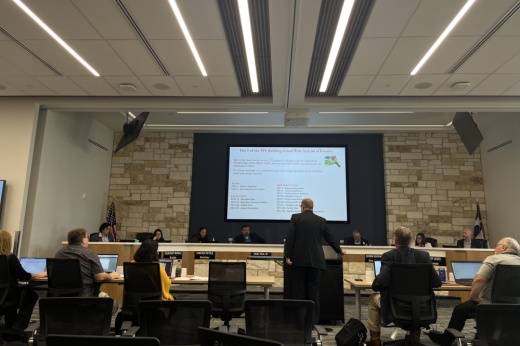Director of Student Services Brian Dawson presented the report during the regular board of trustees meeting May 13.
Breaking it down
Dawson said there has been a decrease in a variety of offenses across the district compared to last year, such as:
- E-cigarettes with nicotine use is down 16%, and felony-controlled substance use is down 45%.
- Possession of alcohol is down 50%.
- Terroristic threats are down 60%.
- Damage and vandalism is down 44%.
- Off-campus truancy is down 28%.
- Aggressive behaviors, including mutual combat, hitting/scuffling and horseplay, are down 10%, 18% and 30%, respectively.
According to PBIS data, across the district there were:
- Seven cyberbullying and seven nonlisted bullying incidents, which accounted for the most bullying offenses
- 91 oral or written threats, which accounted for the most assaultive behavior offenses
- 128 recorded e-cigarette uses, followed by 125 recorded marijuana uses, which accounted for the most drugs, alcohol or tobacco offenses
- 624 hitting/scuffling incidents, which accounted for the most fighting/aggressive behavior offenses
Dawson said there has been a consistent increase in attendance across elementary and middle schools throughout the year, but the district is still below its attendance goal—96%—at 93.92%.
“We have a lot of students who are leaving, and they give us some general information, and then we have to track them down,” Dawson said. “So we’re looking to find a way where we can have a cleaner process [and] more efficiently identify where they’re going in a quicker manner.”
Per PBIS data, daily attendance averaged:
- 94.05% at the elementary campuses
- 93.89% at the middle school campuses
- 90.96% at the high school campuses
What’s being done
Dawson said there are several areas of focus, such as making discipline labels less generic so data is easier to aggregate and campuses are better supported, and creating a 2024-25 discipline guide with recommendations to administrators for responding to specific offenses.
With disciplinary offenses, Dawson said implementing the Multi-Tiered Systems of Support approach allows administrators to take disciplinary action on a case-by-case basis, rather than giving students a blanket response or the same consequence. MTSS also guides campuses on how to involve families.
“One of the things that we’re really trying to focus on is ... is there a need, a barrier or anything that we can work to identify to help get their students to school and also help get their parents more engaged in the campus?” Dawson said.
Dawson added that through partnering with members of the local court system, the team is looking at attendance consequences to increasing the likelihood of students going to school, such as collaborating with the campus they attend to coordinate community service hours.
How it's going
Dawson said there have been a number of campus successes. Attendance office staff meet with each high school attendance team weekly, and campuses are continuing to be creative in incentivizing student attendance. Many discipline referrals are also being handled in the classroom to keep students there instead of in the office.
Looking ahead
At the legislative level, Superintendent Eric Wright said he is going to push for students to have to be in class 94%-95% of the time in get course attendance credit, as well as for districts to receive funding based on enrollment, not attendance.
“As we start preparing for our legislative priorities for this year, one of the problems—and it’s a great challenge for us at the high school level—is to get course attendance credit; you only have to be present for 90% of the time,” Wright said. “Our kids are smart. They’ve figured this out. ... I don’t know why the state has set the bar so low, but our kids have figured that out. They come just enough to get credit.”





